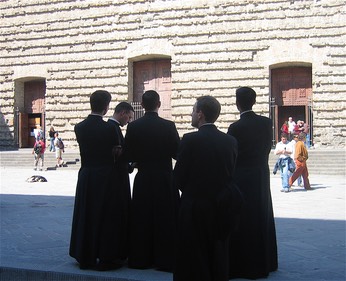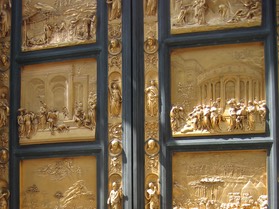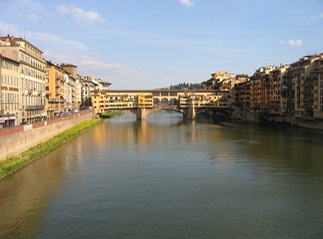
Florence has immense riches in sculpture, art and architecture. Yet not everything is quite as it first appears. Consider Michelangelo's David. On completion(1504) the sculptor and his supporters campaigned strongly for a prominent site at the entrance to Palazzo Vecchio as the huge weight precluded it from being lifted onto the Duomo. Leonardo da Vinci – reportedly unimpressed by Michelangelo's work - preferred a less imposing location under cover in the adjacent Loggia. Had Leonardo prevailed it might never have been necessary to remove the original into the Accademia Gallery for protection in 1873. A replica was substituted in 1910. Convincing - but not authentic.
Likewise Ghiberti's doors at Florence's 12th century Baptistry were removed to Museo dell'Opera dell Duomo in 1990. The guilt bronze panels were so admired by Michelangelo that he named them ‘Gates of Paradise’. Centuries later these originals were removed to be laser cleaned. Again reproduction panels are now substituted. Convincing - but not authentic.

Arriving at the understated San Lorenzo church a visitor might easily be distracted by the vibrant adjacent market. To miss its spectacular interior and sacristies, one by Michelangelo and an older one by Brunelleschi, would be folly. Brunelleschi’s rebuilding of this church waited a century for Michelangelo’s marble façades, but 16th century austerity left this masterpiece eternally ‘undressed’.
The vast Santa Croce faired better with its ornate frontage, yet an adjacent cloister leads to an unmarked gem. The Pazzi Chapel, thought to be among Brunelleschi’s finest work, was completed (1443) only three years before his death.
Florence Cathedral designed by Arnolfo di Cambio (1294) took 120 years to construct before Brunelleschi won the competition (1419) resolving the impossibly huge dome using ingenious stone chains as ‘ring beams’. Surprisingly Duomo also remained ‘undressed’ until 1880’s when white, green and red marble was applied (designer: Emilio de Fabris).

Consider also the historic bridges across the Arno demolished (1944) by retreating German forces. Original stones and statues were used to faithfully reinstate the damage. Convincing - but not authentic. Thankfully Ponte Vecchio was spared destruction. As sole authentic survivor it reveals so much more about life since 1345 than any replica. The bridge originally accommodated fishmongers, butchers and tanners on stall tables. The projecting back-shops and upper floors were later additions when goldsmiths became favoured as more fragrant traders on the bridge.
An audacious project for Cosimo I de Medici transformed Ponte Vecchio (1565). A covered link of around one kilometre built between Palazzo Vecchio and the new Palazzo Pitti passed through the Ufficci Gallery; formed a tall arcade along the river; crossed Ponte Vecchio [forming a fourth floor]; passed round Torre de Manelli on massive brackets; through the church of Santa Felicita and over houses in Oltrarno. Vasari’s Corridor truly demonstrates architecture of absolute power.
Florence’s renowned Niccollo Macchiavelli become inextricably associated with duplicity. His keen interest in conspiracy and legitimacy -or otherwise- of authority earned him imprisonment and torture in 1513. Perhaps we should simply enjoy Florence’s vast treasure and not be too concerned with removal of originals - or indeed their replacement with dummies.
514 words.